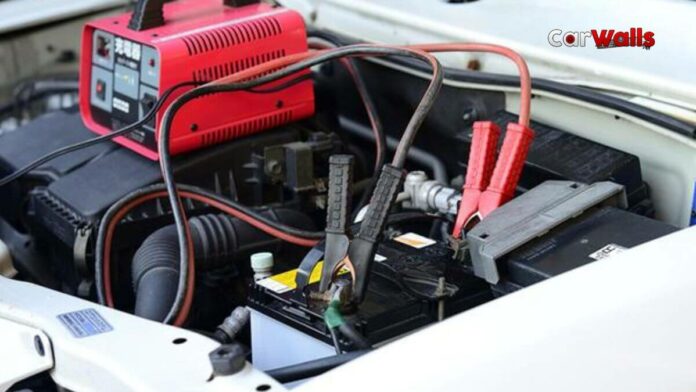Car Battery Dead Will It Recharge By Itself: Drivers are confused and confused about whether a car battery can recharge on its own overnight. This uncertainty may lead to incorrect beliefs about the battery’s lifespan and charging, which could damage the battery or cause unforeseen problems while driving. It is important to provide drivers with correct information on how car batteries work, how long they normally last, and if they can self-charge.
Will a car battery be refilled by morning? The answer is yes, however, it also depends on the engine speed, battery capacity, age, alternator output, and electrical load.
Stay with us; we’ll talk about how automobile batteries charge and whether or not a completely dead battery can be recharged overnight. Additionally, we will provide some tips on maintaining and increasing your car battery’s lifespan.
Factors That Affect Car Battery Recharge:

Before answering whether a car battery can recharge itself overnight, it is important to understand the many factors affecting battery recharge
- An automobile battery’s capacity is expressed in amp-hours (Ah). It refers to the amount of power that a battery is able to store. A battery’s capacity determines how long it will take to empty and recharge.
- Alternator Output: The alternator is responsible for recharging the battery when the car is in motion. A greater output alternator will refuel the battery more quickly because its output is measured in amps.
- Age of battery: As batteries age, their capacity decreases and their recharge times lengthen. Batteries older than five years are more susceptible to needing outside influence to recharge
Car Battery Dead Will It Recharge By Itself

Unfortunately, jumping a car battery is a very common occurrence and almost everyone will have to do it at some point in their lives!
Because of how frequently cars need to be jumped, it is very important to know how to safely jump-start a car. Whether it is your car or someone else’s, this knowledge will come in handy.
Steps to Jump-Start a Car:
Step 1: Keep a set of jumper cables in your car.
A set of jumper cables is among the essential tools to keep in your vehicle. It can be challenging to locate a willing volunteer with jumper wires if your car battery fails.
You won’t ever have to worry about needing to locate jumper wires if you keep some on hand
Step 2: Put both cars in the park or neutral with the ignition off.
Additionally, the parking brake needs to be applied. You considerably limit the possibility of getting wounded while connecting jumper wires to the battery by turning off the ignitions.
Step 3: Attach the red clamp to the dead battery.
The red clamp on the dead car’s positive terminal needs to be connected to the wires’ first battery connection. A “POS” or a “+” adjacent to the positive terminal is frequently used to denote it.
If not, then know that the positive terminal is always the bigger terminal.
Step 4: Attach the other red clamp to the working battery.
Again, make sure that it is connected to the positive terminal of the battery.
Step 5: Attach a black clamp onto the working car’s battery.
This clamp goes on the negative terminal which is usually indicated by a “NEG” or a “-“.
If the battery does not identify it this way, know that the negative terminal is the smaller of the two.
Step 6: Clip the last black clamp onto an unpainted, metal part of the dead car.
To prevent sparking, make sure that the metal part it is clamped on is not near the battery. Always attach red clamps to positive terminals first and then black clamps onto negative terminals.
Step 7: Start the working car and let it run for a few minutes.
This will give the dead battery a chance to be charged a little bit so
Step 8: Keep the engine on and drive the car around for 15 to 30 minutes.
This will help ensure that the battery is charged more so that when you go to start the car again, it will not need to be jumped again.
Frequently Asked Questions
Que 1: How Long Does a Car Battery Take To Fully Recharge?
Ans: In general, the alternator will charge your battery more quickly if you can keep your engine’s RPM high. Your automobile battery should be able to charge in 30 minutes if you are travelling on a highway. Driving across the city may take an hour or longer.
Que 2: What Occurs If A Car’s Battery Is Fully Dead?
Ans: After your car has been shut off, you might not be able to start it. However, if the alternator isn’t working correctly and the battery releases, your car may eventually run out of electricity and stall or shut off entirely.
Also Read: KEEP THE KEYS TO YOUR LIFE CHARGED AND READY WITH THE HYUNDAI KEY FOB BATTERY
Conclusion
When a battery dies, not all of them can be replaced. As a result, batteries occasionally drain to the point of death. Batteries are consumable items, and even though they can be recharged, there comes a time when they all lose the ability to hold a charge and must be replaced.
If you frequently need to jump-start your automobile, your battery may not be retaining a charge very well. Your best course of action is to replace the battery as soon as possible since otherwise it will eventually fail and stop working entirely.


![How Long Can You Drive Without An Oil Cap? [Briefly Explained] How Long Can You Drive Without An Oil Cap?](https://carwalls.org/wp-content/uploads/2023/05/Untitled-design-15-1-218x150.jpg)




